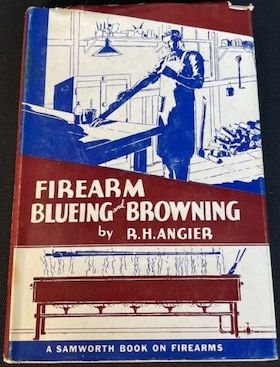
Curated with aloha by
Ted Mooney, P.E. RET

The authoritative public forum
for Metal Finishing 1989-2025

-----
Bluing/Black Oxide/Zinc Phosphate
Q. I'm interested in blueing/Black Oxide finishes for gun restoration.
Wondering how to obtain a rich, dark, blue, shiny finish?
HOBBYIST - Tucson, AZ
May 12, 2022
A. Hi Justin. If the metal is very highly polished and shiny, proper application of hot black oxide will produce what you are looking for; you need oil or wax anyway, and the wax will enhance the shine.
As for "proper application" please search the site for 'black oxide' and you'll see instructions plus dozens of trouble-shooting instructions for when things go wrong which they will. But be warned that hot black oxide is one of the more dangerous finishing processes because it operates at well above boiling, so the water evaporates rapidly, but randomly adding water can cause it to instantly turn to steam and cause the hot, caustic, solution to erupt. Proper PPE and training is needed.
Luck & Regards,

Ted Mooney, P.E. RET
Striving to live Aloha
finishing.com - Pine Beach, New Jersey
May 2022
 Forget black oxide -- too dangerous a process for hobbyist; try cold black oxide (selenium based) or some of older processes (Angiers book Firearm Blueing & Browning is good source of info). Hope it helps and good luck!
Forget black oxide -- too dangerous a process for hobbyist; try cold black oxide (selenium based) or some of older processes (Angiers book Firearm Blueing & Browning is good source of info). Hope it helps and good luck!
- Cerovski vrh
May 13, 2022
![]() Thank you, many warnings about the hot black Oxide, thank you for the quick answer, I appreciate the information, I am investigating your suggestions now...
Thank you, many warnings about the hot black Oxide, thank you for the quick answer, I appreciate the information, I am investigating your suggestions now...
Thank you,
Justin
HOBBYIST - Tucson, Arizona
May 13, 2022
⇩ Related postings, oldest first ⇩
Q. I was wondering how the Bluing process compares to Black Oxide or Zinc Phosphate coatings? Also how thick of a coating does the bluing process provide and how does it hold up in salt spray corrosion testing IAW ASTM B117 ?
Thanks.
Robert S [last name deleted for privacy by Editor]- Atlanta, Georgia
2001
A. Black oxide and blueing are one in the same as far as chemistry is concerned. The difference is the amount of polish that the steel part receives prior to the oxide process. Generally, the higher the polish the "bluer" the appearance will be. Some call this blue color an iridescent color. Call on us for further questions.
Tom WalenSpringfield, Massachusetts
2001
A. Hi Tom explains it pretty succinctly, black oxide & bluing are the same thing. If the process is applied to a highly polished surface it comes out a beautiful dark blue jewel-like finish. If applied to a rough surface, it comes out black -- perhaps due to increased surface area, so more surface and more black oxide, and some of the light bouncing back and forth before reflecting back.
Black oxide / bluing offers virtually no corrosion protection; it is intended for surfaces that will be lovingly waxed and oiled. It is extremely thin, measured in millionths of an inch rather than ten thousandths.
Zinc phosphate is something very different -- it's a pretreatment for painting, not a final finish.
Luck & Regards,

Ted Mooney, P.E.
Striving to live Aloha
finishing.com - Pine Beach, New Jersey
Q, A, or Comment on THIS thread -or- Start a NEW Thread
